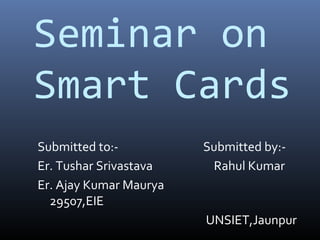
Smart card
- 1. Seminar on Smart Cards Submitted to:- Submitted by:- Er. Tushar Srivastava Rahul Kumar Er. Ajay Kumar Maurya 29507,EIE UNSIET,Jaunpur
- 2. Overview INTRODUCTION EVOLUTION TECHNOLOGICAL FEATURES CLASSIFICATION CONTACT INTERFACES FABRICATION APPLICATION ADVANTAGE AND DISADVANTAGE FUTURE
- 3. What is smart card? Standard credit card-sized with microchip embedded on it. Any pocket-sized card with embedded integrated circuits. Can hold up to 32,000 bytes. Follow the MOORE’s law. On a fundamental level, microprocessor cards are similar to desktop computers.
- 4. EXAMPLES OF SMART CARDS
- 6. EVOLUTION OF SMART CARDS HISTORY 1950-Used by diners club in 1950 as a plastic card 1968- German inventors patent combination of plastic cards with micro chips. 1970- Japan patent different version. 1974- Roland Moreno invents integrated chip card and patents it in France. 1977- Motorola produces first smart card microchip. 1979- Motorola develops first single chip microcontroller for bank in France.
- 7. 1982- ATM cards with smart chips tested and smart chips placed on telephone cards. 1991- AT&T declared its contactless smart card. 1992- Germany uses smart card for health care. 1996- First university campus deployment of chip cards. CURRENT TRENDS Latest super smart cards have keypads, LCD displays, battery and math co-processors for performing complex encryption algorithms.
- 9. TECHNOLOGICAL FEATURES 256 bytes to 4KB RAM. 8KB to 32KB ROM. 1KB to 32KB EEPROM. Crypto-coprocessors (implementing 3DES, RSA etc., in hardware) are optional. 8-bit to 16-bit CPU. 8051 based designs are common. Length=4.96mm Breadth=4.28mm Chip area=21.33mm2 COS
- 12. CLASSIFICATION OF SMART CARDS MEMORY CARDS MICROPROCESSOR CARDS IC MEMORY CARDS Holds a microprocessor or Can store data,but do not microcontroller chip. have a processor on the Can add,delete and card. manipulate information in OPTICAL MEMORY its memory. CARDS COS Can store only data,but has a larger memory capacity than IC memory cards.
- 13. DIFFERENT TYPES OF CONTACT INTERFACES 1. CONTACT SMART CARDS 2. CONTACTLESS SMART CARDS
- 14. Proximity cards Remote cards 3. COMBI/DUAL INTERFACE CARDS Dual interface cards Combination of smart cards and biometric devices
- 15. STANDARD DIMENSION FOR SMART CARDS
- 16. CONTACTS OF THE SMART CARD MODULE
- 17. FABRICATION OF SMART CARDS
- 18. Chip specification Card specification Mask ROM specification Application software specification Chip fabrication Card personilisation Applicatin activation Application load
- 19. APPLICATION OF SMART CARDS 1. FINANCIAL APPLICATIONS Electronics purse Telephone payment cards 2. GOVERNMENT APPLICATIONS National ID card Driving license 3. HEALTH APPLICATIONS Patient data card Health professional card
- 20. 4. CAMPUS SOLUTIONS Student identification Library cards Meal cards Transportation cards 5. EMPLOYEE CARDS ID cards Access cards Time attendance system
- 21. 6. COMMUNICATIONS AND ENTERTAINMENT SIM Subscriber activation card for pay-TV 7. INFORMATION SECURITY PC Security cards Digital signature Encryption Telecommuting And Corporate Network Security
- 22. ADVANTAGES OF SMART CARDS CONVENIENCE INTELLIGENCE MULTIFUNCTIONALITY ECONOMIC BENEFITS CUSTOMIZATION SECURITY PERSONALISATION
- 23. DISADVANTAGES OF SMART CARDS FLEXIBILITY HARSH ENVIRONMENT SECURITY IS NOT ALWAYS 100 %. LACK OF STANDARDS FOR FUNCTIONALITY AND SECURITY.
- 24. Plastic Cards Visual identity application Plain plastic card is enough Magnetic strip (e.g. credit cards) Visual data also available in machine readable form No security of data Electronic memory cards Machine readable data Some security (vendor specific)
- 25. Smart Cards Processor cards (and therefore memory too) Credit card size With or without contacts. Cards have an operating system too. The OS provides A standard way of interchanging information An interpretation of the commands and data. Cards must interface to a computer or terminal through a standard card reader.
- 26. Smart Cards devices GND VCC VPP Reset I/O Clock Reserved
- 27. Smart Card Readers Computer based readers Connect through USB or COM (Serial) ports Dedicated terminals Usually with a small screen, keypad, printer, often also have biometric devices such as thumb print scanner.
- 28. FUTURE OF THE SMART CARD I believe smart cards are the wave of the future for consumer use, commercial use and internal network security. Europe already has a head start on the U.S., as smart cards are in much wider use there. With this technology identity theft and credit card fraud can be controlled to a great extent. Further it will give a fillip to the Internet commerce. It will be no exaggeration to predict that the future belongs to contact less smart card supporting multiple applications.
- 29. Any queries
